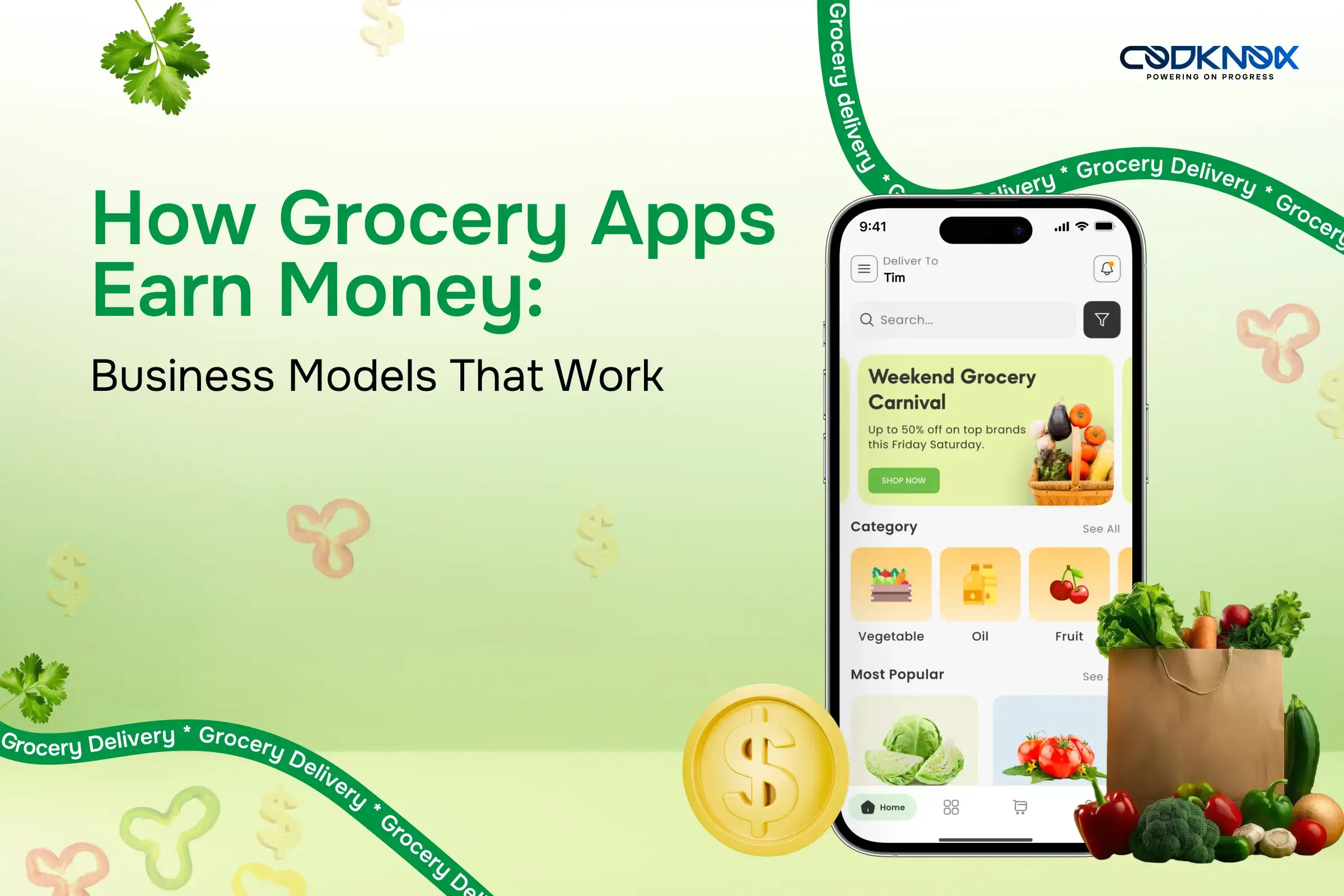Grocery delivery apps have completely transformed the shopping experience. Due to the high demand for doorstep grocery delivery services, new businesses and entrepreneurs are gravitating toward this industry and hoping to profit from it as it continues to grow. Revenue generated from grocery apps in the USA is expected to exceed $45 billion by 2029. It’s reasonable to say that grocery app development would expand due to numerous reasons, such as increasing demand, dependence of people on such apps, rise of digital payments, wide product choices, personalization, and discounts.
If you run a food business and want to build a grocery delivery app, then there is no better time than now! Through this blog, we share how the grocery app works, different business models, and how they make money. So, read on to know how you can make a profit and start the app development journey.
Top Grocery Delivery App Business Models
-
Inventory Model
A business uses this model to hold goods or supplies straight from suppliers. Orders are picked up from the vendor by a delivery partner, who then distributes them via an internal or external supply network. Regardless of the vendors, the site’s logo is used to distribute the orders to customers. In specialty and single-product stores, like daily milk supply, vegetable supply, etc., this concept is typically utilized for convenience. Businesses have larger profit margins when they handle the supply chain completely through direct purchases.
Because the strategy requires warehouse management, quality standards, transportation, and warehouse setup, it is costly. Taking into account the first investments, the inventory model appears more hopeful about the e-grocery business.
-
Hyper-Local Model
The hyper-local marketplace meets the needs of a limited area, as the name implies.
Grocery distribution, grocery ordering, home shopping, personal care services, etc., have all significantly increased the success of hyper-local e-commerce companies.
Local offline retailers and service providers have been given new leases for their businesses as a result of the growth and development of hyperlocal networks. Because of the internet’s widespread use, even though the concept is new, the world is no longer new. It has the power to raise offline retailers’ businesses to entirely new heights. Hyper-local e-commerce companies’ desire to offer goods and services quickly is their USP.
-
Marketplace Model
This grocery delivery app business model reduces the gap between consumers and multiple grocery vendors. The platform does not hold its stock; instead lists products from partner stores, offering users a wide range of selection. Under this, businesses earn money through commission on each order. If you cannot have a dedicated warehouse or store bulk products, then this can prove to be cost-effective, easier to scale across different regions, and highly attractive due to the variety of options offered to users.
-
The Shopping Model
While the shopping model functions similarly to the multi-seller model, customers do not select the store where they wish to buy the product before placing their order. The application manages its distribution network. If an order is placed, the business notifies its vendors, who then have the responsibility of purchasing and delivering the goods to its customers.
Instacart is based on this idea. Additionally, they refer to their delivery personnel as “supermarket shoppers who shop on behalf of customers.” A number of sizable internet food supply companies have grown as a result of this approach. Networks should also make use of the current business model and infrastructure to offer couriers, gifts, and other items.
How a Grocery App Works?
A grocery app connects users, local vendors, and delivery partners on a single digital platform. The process of delivering a product starts when a consumer browses categories, selects the items, and finalizes the items in the cart. Once a product is placed, the selected store gets a notification and begins assembling the order. After the packaging is done, a delivery partner is assigned to pick up the order and bring the same to the customer’s doorstep. Most of the mobile apps offer a secure payment gateway, real-time order tracking, and flexible delivery slots to make the shopping experience happier and more satisfactory. You can hire dedicated developers to construct a seamless app; they can guide you as well regarding the shortcomings and give beneficial suggestions.
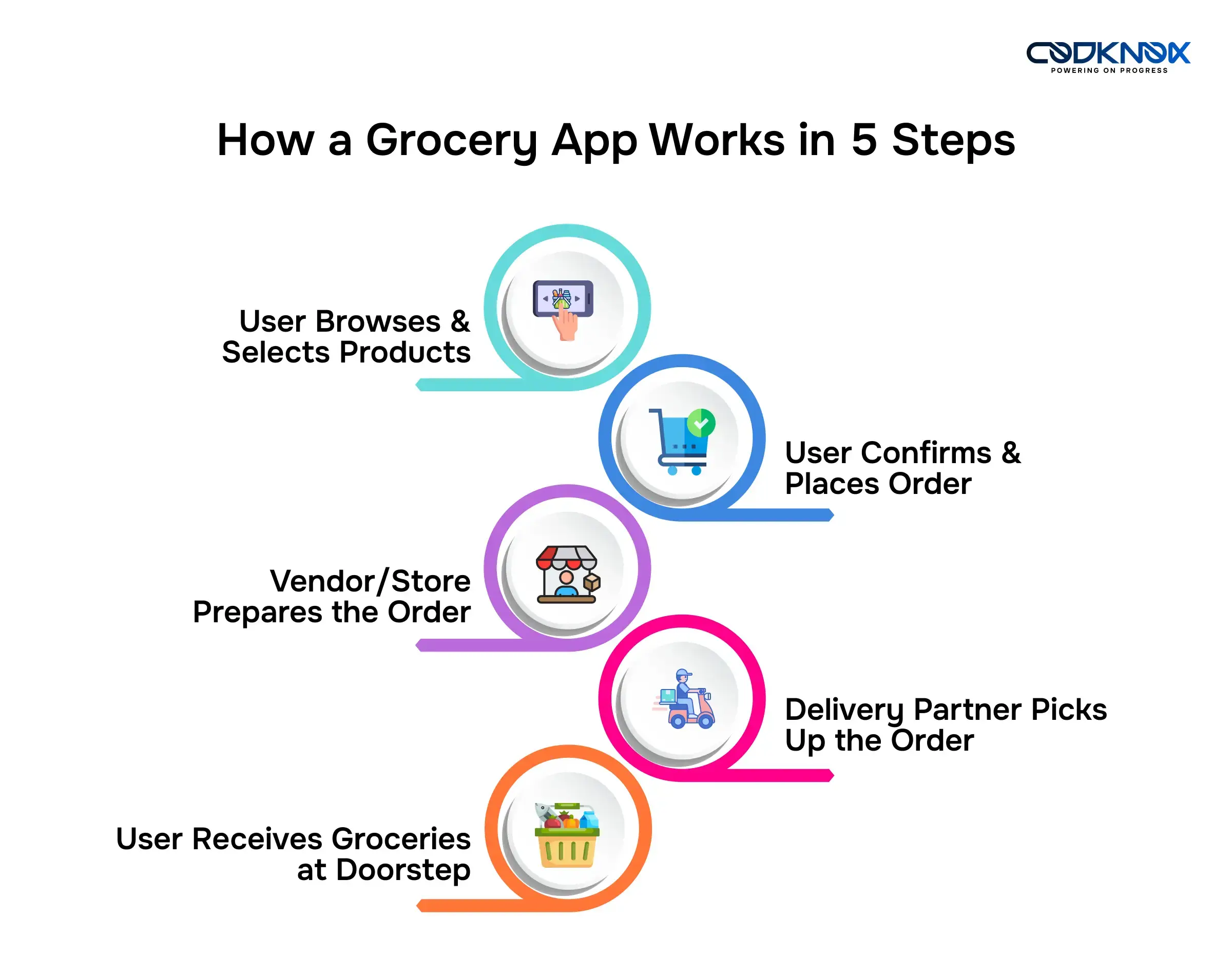
How Grocery Delivery Apps Generate Revenue
Revenue generation is one of the primary driving forces behind the development of a grocery app. There are numerous methods used by businesses to drive revenue. We have mentioned them below. Read on to find out how grocery apps make money.
1. Delivery Service Fee
The delivery service fee is a common business strategy used by on-demand ordering and delivery apps. In this business model, the app charges customers for every delivery made through its platform. The app is maintained with the money collected from this fee. It is covered by the order’s total cost. The goal of this service is to cover the costs associated with delivery services, such as paying partners, managing logistics, app updates, and providing consumer support.
2. Subscription Packages
Another grocery delivery app revenue model is through subscription packages. For vendors, this approach gives them a radical alternative to commission-based payment by either having a monthly payment or a yearly one. Sellers can ask for payment for the platform’s services, listings, and wider consumer base. For consumers, subscription packages offer benefits such as offers, discounts, and others.
3. In-App Advertising
Numerous companies and retailers spend money on sponsored listings, banner ads, featured products, and premium ad placement. Advertising may emerge as one of the primary revenue-generating sources for the app. Through the platform, advertisers pay for premium placement in order to raise product visibility and boost sales. This strategy is one of the most widely used monetization strategies because it not only gives the grocery delivery app heightened revenue but also offers significant advertising advantages by connecting with customers at the precise moment of purchase intent.
4. Premium Listings
With this arrangement, brands and retailers can choose to pay more to have their names displayed prominently on the grocery delivery platform’s homepage or in search results. Sales for that specific brand or retailer are increased as a result of the product’s increased visibility.
Without degrading the user experience, this technique also aids in the generation of ad revenue. These models eventually influence user purchasing decisions by fostering focused promotional campaigns and strategic brand collaborations.
10 Key Features of Grocery Delivery Apps
Features are one of the most important additions to a grocery app. On-demand grocery app development features mainly have four apps;
- User app
- Vendor panel
- Delivery partner app
- Admin panel
All of these have a dedicated list of features. But there are 10 prime features that cannot be missed in the development process. To know these features, go through the image below:
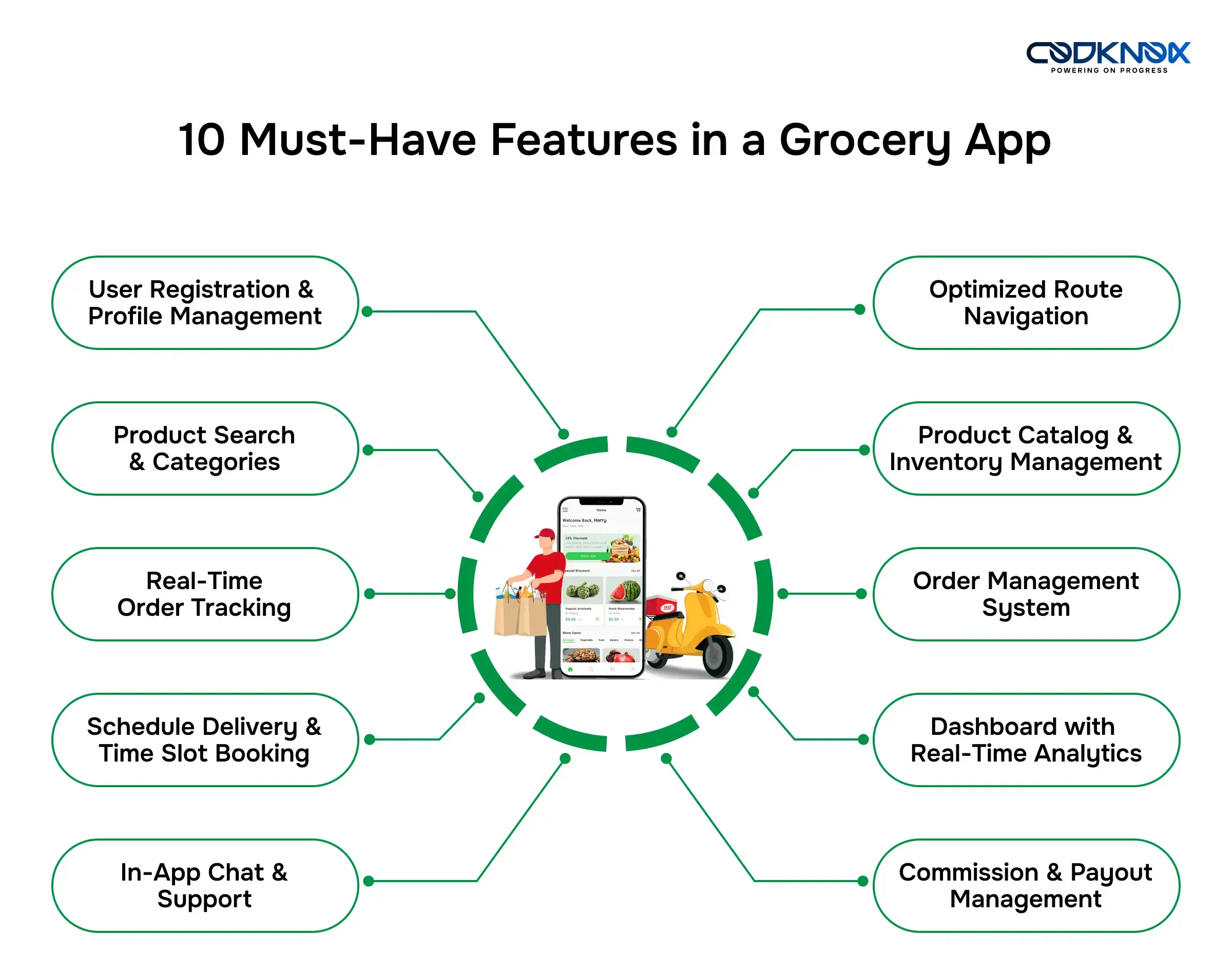
Grocery Delivery App Development Cost
The intricacy of the design, functionalities, technology stack, and experience of the development team are some of the variables that affect the price of developing a grocery app. While a complex app with real-time tracking, AI-based suggestions, and numerous integrations demands a larger budget, a basic grocery app with basic functionality like product lists, cart, and checkout may typically cost less to develop. Companies should also account for recurring costs like server maintenance, updates, and other fees. In general, the range of investment levels for grocery app development is moderate to premium. See the table below to know the cost in detail.
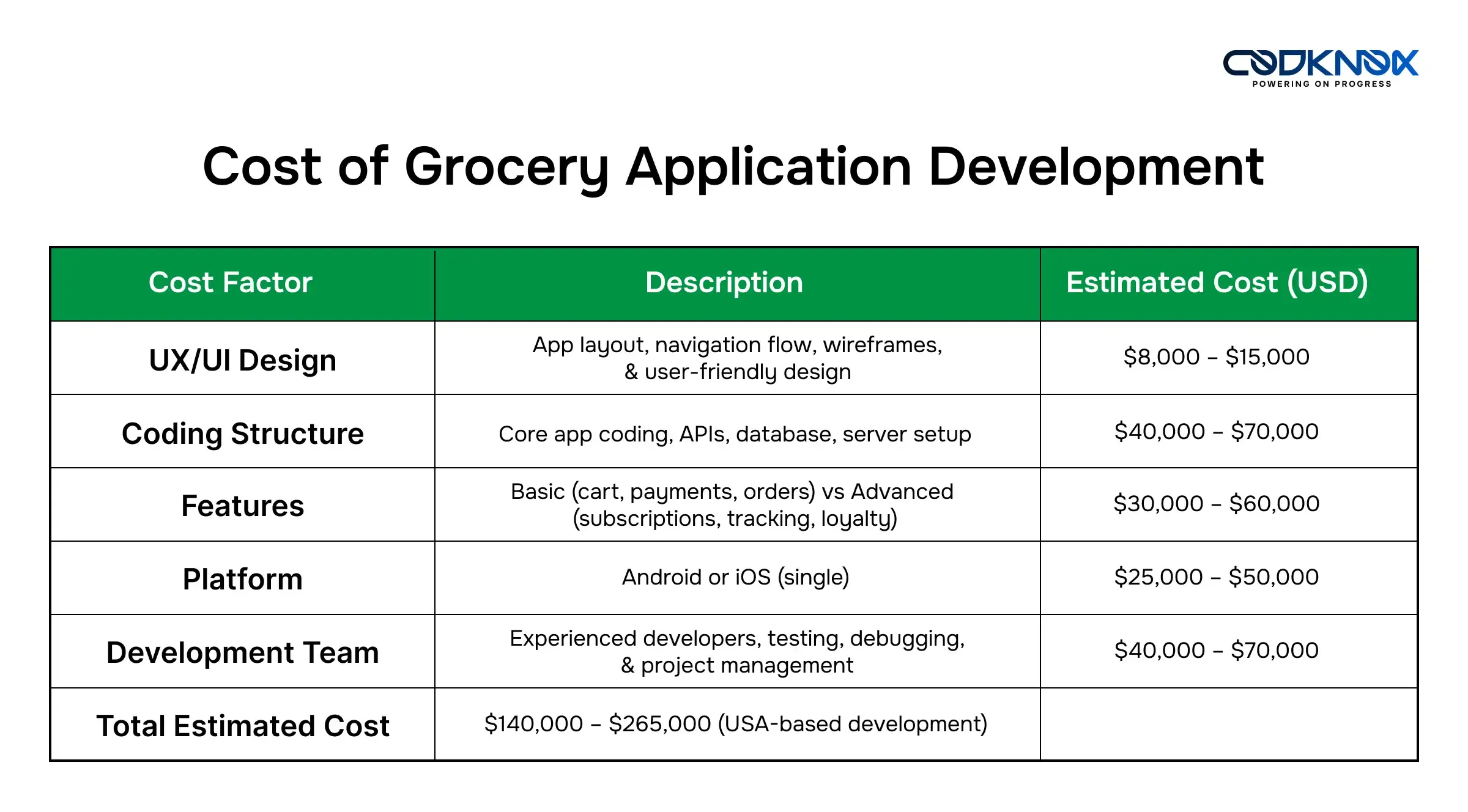
How Leading Grocery Delivery Apps Generate Revenue
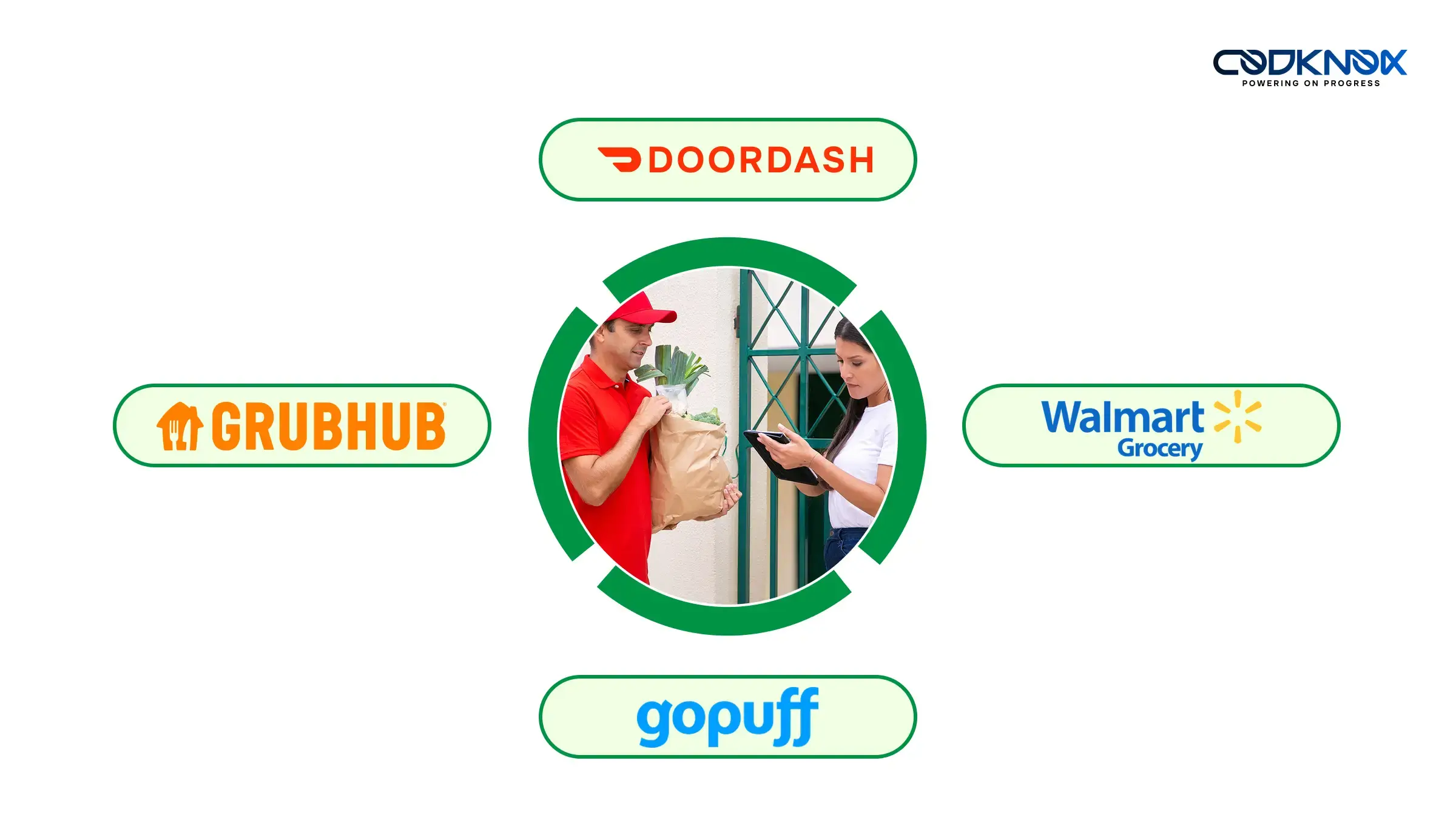
1. DoorDash
DoorDash Business Model: Marketplace + Logistics Model
Strategies for Monetization:
- Fees for delivery and services
- It is a subscription model
- Commissions to retailers
- Advertisements and sponsorships
- Logistics under white label (DoorDash Drive)
2. Grubhub
Grubhub Business Model: Marketplace + Commission-Based Model
Strategies for Monetization:
- Fees for delivery and services
- Subscription model (Grubhub+)
- Commissions to restaurants
- Advertisements and sponsorships
- Expedited payments (“Pay Me Now” fees)
- Gift cards
3. Walmart Grocery
Walmart Grocery Business Model: Inventory-led model
Strategies for Monetization:
- Delivery fees
- Walmart+ subscriptions
- Product margins
- In-store pickup option
- Ads & promotions
4. Gopuff
Gopuff Business Model: Inventory-led + Micro-Fulfillment Model
Strategies for Monetization:
- Product markup
- Delivery and service fees
- Subscription model (Gopuff Fam)
- Advertising and promotional placements
- Private-label products
Ready to Build a Grocery Delivery App?
The grocery app development industry is growing at a great speed, and building a feature-rich app is the ultimate key to staying ahead in the competition. From the right business model to the necessary features, one must know what steps to take to create a fascinating app. If you are also planning to launch your own platform, partnering up with a professional and reputable grocery delivery app development company like Codknox can make the process faster, smarter, less hectic, and more cost-effective.
Get in touch with the CodKnox team today by filling out the form on the right side and turn your grocery app idea into a radical reality!
Frequently Asked Questions (FAQs)
Q1. How much does a grocery app development cost?
A grocery app development price range between $10,000 and over $100,000. However, the final cost depends on numerous factors, such as features, platform choice, third-party integrations, and other significant factors.
Q2. What type of features are necessary in a grocery app?
Numerous features must be integrated in a grocery app, such as;
- User registration
- Real-time tracking
- Route optimization
- Product search
- Schedule delivery
- Dashboard with analytics
Q3. Can small retailers launch a grocery app?
Yes, local retailers can also build a grocery app with basic features such as product listings, cart, and secure payment.
